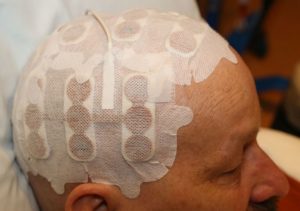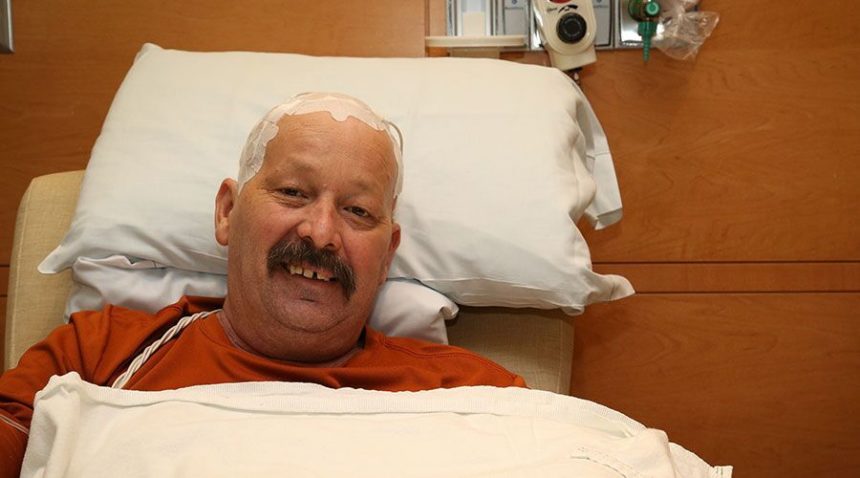For patients with glioblastomas (GBM), treatment options are limited and the tumors are often resistant. But a treatment called Optune might be changing that.
“This is the first device approved to treat glioblastoma in the clinic,” says Simon Khagi, MD, director of the UNC Brain Tumor Program. “It’s a pretty big step for this disease because we really haven’t had anything new in a couple of decades.”
What is Optune?
Optune is a wearable, portable device that attaches to a patient’s scalp via four adhesive transducer arrays. The arrays are about palm-sized and are placed adjacent to one another. “Then they develop this alternating electrical field between those opposing arrays,” Dr. Khagi says.
This electrical field disrupts the cellular division process, which is key to the advancement of GBM. “When you introduce that electrical field into that space, it disorganizes the way the microtubules are constructed, and therefore the cell cannot divide into daughter cells,” Dr. Khagi says.
Patients who have the most success with the Optune device wear it for at least 18 hours a day. Although it might sound extreme, the results speak for themselves. “It’s hard to argue when there’s a median survival advantage of about five months,” Dr. Khagi says. “That’s a big deal in our disease, when life expectancy is about 15 to 17 months.”
Who are the best candidates for Optune?
The Optune device is approved only for tumors in the cerebrum. “Anything in the cerebellum, the back of the brain, the device is not approved for, so we can’t use it in those patients,” Dr. Khagi says.
In a newly diagnosed setting, Optune is introduced in treatment as patients are undergoing maintenance chemotherapy, a stage in which they are being monitored for signs of cancerous progression.
“While they’re on the maintenance course of chemotherapy, they would be on the Optune device concurrently, so they would wear it during chemotherapy and on those days when they’re off chemotherapy,” Dr. Khagi says. “Those individuals that are just starting a maintenance chemotherapy course are very good candidates because they aren’t as sick as those whose disease is coming back. The sooner the better is my mantra to use this device.”
Dr. Khagi also says that people who are motivated and willing to keep the device on their head for the necessary 18 hours per day—and who have a strong support system to help apply the device, monitor toxicity and check the scalp for skin health—will have the most success.
What are the risks?
Like any other treatments, there are some risks attributed to using the Optune device.
“Being hooked up to a device can be somewhat of a burden, to walk around with it—your disease is on display,” Dr. Khagi says. “I can envision some people might feel restricted by the stigma and wearing this device on their head at all times.”
However, the device still allows patients independence.
 “When I was walking through Los Angeles International Airport, I bumped into a gentleman who was walking into the bathroom wearing this device, and I honestly would not have noticed him wearing this device if I wasn’t prescribing it and knew what it was,” Dr. Khagi says. “It was fairly inconspicuous. He was wearing a hat, and the arrays were connected to wires that were braided and put down his shirt. He was living his normal life.”
“When I was walking through Los Angeles International Airport, I bumped into a gentleman who was walking into the bathroom wearing this device, and I honestly would not have noticed him wearing this device if I wasn’t prescribing it and knew what it was,” Dr. Khagi says. “It was fairly inconspicuous. He was wearing a hat, and the arrays were connected to wires that were braided and put down his shirt. He was living his normal life.”
Because of the device’s placement on the head, it has caused skin to break down in some cases, though Dr. Khagi says this isn’t common in his experience.
A patient is also unable to use Optune if he or she has skull defects. “If there are defects where the skull is missing or had to be removed for a specific reason, they can’t wear the device,” he says.
Then there’s the cost: The Optune device costs about $21,000 per month.
“The problem is that because this is something that you have to wear all the time, and if it’s working, it really shouldn’t be discontinued unless a patient has been totally stable for many years,” Dr. Khagi says. “Frankly, we don’t know how long we need to wear this device. That really does add to the cost, because let’s say patients are doing very well—there’s going to be very little incentive for me to want to stop it as a physician. I’m sure patients would also be reluctant to stop it if they know that this is the only thing in their lives that is potentially keeping this disease at bay.”
What does Optune mean for the future of GBM?
Despite its risks, the Optune device opens the door to a new type of multichannel approach to treating GBM. UNC Medical Center is one of only 250 certified centers in the country, which requires special training. Dr. Khagi says the device has been used on patients with great outcomes.
“I think it’s a big step forward, and it represents our ability to think outside the box and use multiple approaches to treating this disease beyond what’s already available,” Dr. Khagi says.
There’s also potential for similar technology to be adapted for tumors in areas such as the chest or abdominal cavity. Research and trials for this type of development are ongoing.
“I’m hopeful as we continue to get more experience with it and combine different chemotherapy agents and different ways of using radiation or perhaps immunotherapy, we can derive more benefits by using this technology,” Dr. Khagi says.
UNC Lineberger Comprehensive Cancer Center has about a dozen labs focused on brain tumor research. Learn more about current studies and Dr. Khagi’s work.

